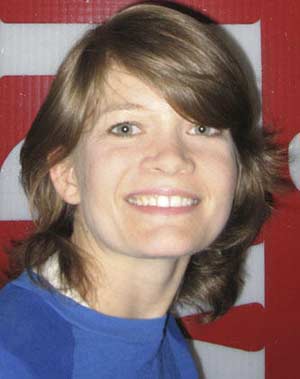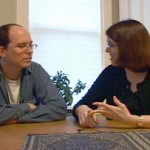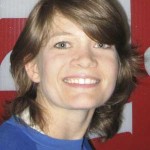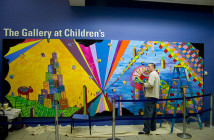When Kelly Sherman began her residency at the Berwick Research Institute’s Artist in Research (AIR) program, she had set out to create a project based on seating arrangements at weddings. When I heard this, I suspected that she was the type of wedding-obsessed person who starts planning their “Big Day” at the age of six and had somehow slipped by the AIR’s curatorial review with a proposal for what was, at the critical level, a insightful yet unorthodox exploration of how a family works. Then I discovered she was also one of the four finalists for this year’s ICA Artist Prize and rethought my initial and rather careless assumptions about Sherman. She was actually a rather successful artist and might very well be seeking to answer some of the same questions I had about why someone would spend two decades planning their wedding (I actually know this person).
Sherman, 27, is the youngest artist to be chosen for the ICA Prize this year, and as far as I can tell, the only one with a MySpace.compage. She admits that she feels lucky, and admires the other artists in the show, though I imagine they can’t but admire hers. This year’s other finalists for the updated and now biennial ICA Prize are Sheila Gallagher, Jane D. Marsching and Rachel Perry Welty. They will each be given a show at the new ICA building’s opening this September and the winner will receive a $25,000 award (formerly just $5k). She has an understated confidence about her work and her successes came early in her career: a four person show at the Barbara Krakow Gallery just a year out of undergrad and just a couple years, several shows and a residency or two later, she is one the four finalists for the ICA prize. She also mentions that she feels indulged; the attention provided by a program such as AIR gives an artist daily encouragement and support in the form of critiques by artists and curators, but also comes with workspace and a stipend.
Sherman began using processes similar to that which are driving her Wedding work at the Berwick with her Family House series about three years ago, a piece that graphically represented her parents’ divorce spatially and chronologically. She began the piece after the proceedings of the divorce ended in an attempt to make sense of everything that had happened, saying now that “if I’m thinking about it, I might as well do a piece about it,” a thought that applies to her Wedding project as well. One section of the House series was comprised of floor plans for the home in which her parents lived and where she grew up and traced the movement of furniture over the course of six months during the divorce. Another piece within the series mapped phone conversations over the same period and like other recent work of hers it’s all very cold and very graphic—“like an annual report,“ she says. Sherman notes that Family House is the most important work she has ever done and believes that it was only when her work started addressing heavier emotional issues that it began to “get good.”
She also began diagramming many samples of her writing—lines of poetry, thrown out sentences from various texts—in her sentence diagrams series. Each grammatical section of a diagrammed sentence was given its own layer of translucent velum in the 2D pieces—the most essential parts appearing on the first layers. In her Dear Diagrams series Sherman took apart entire letters which she had written and grouped all the nouns, verbs, adjectives, etc together into a bar-graph like form. The letters she chose were often high emotional content and perhaps not surprisingly, without their context the words from these letters ended up being rather mundane though humorous stacks of ‘you’s’, ‘me’s’ and ‘I’s’ Sherman noted. “[My work] starts with structure, as its subject in many ways… addresses everything by looking at its structure,” she says. It is “calming… in a kind of compulsive kind of way.” “I think a lot of my work is a way for me to, on one hand, understand my subjects but also to kind of control them in my own way.” She opens up an immaculately constructed FileMaker database of her work and states jokingly, “I’m a little obsessive compulsive in the organizational arena.” I ask if that informs her work and she laughs, “Totally!”
Every AIR participant has the option of keeping a journal so patrons of the Berwick can keep up with the current AIR project. Sherman’s journal is copious with entries and reads like a diary, an uncommon trait of the journals of most Artists in Research at the Berwick. She is very open and engages in dialogs with herself where she shifts back and forth over what and who the project is for and about. Sometimes it sounds as if she is speaking to a therapist. In speaking with her, I asked if she found anything out about herself in making these works, and it was the toughest question for her to answer. Her voice wavered and she looked down at table, her palm went to her forehead and she pushed back her hair, though she didn’t hold back. You can get a sense of Sherman’s psyche by looking at her body of work, it is indeed obsessive and compulsive, but as she is conscious of this quality of hers her work seems to be self-conscious as well. In many cases it seems to be the work is itself a self-reflexive exercise in OCD and is, as she says, “calming.”
In creating her work, she is driven by curiosity, the desire to figure out. She muses that there is no other way for one to go into investigations like this except for therapy. “…exploring the world, or yourself, or other people, or emotions in general, in a way that doesn’t fit into an established mode in our culture…, it’s called art,” she exclaims; and it is this methodology which the AIR program was founded for. Her process to create work is research based, and the “AIR program seeks to support artists involved in the early stages of projects that require investigation and dialogue,” as the Berwick’s website states.
At the time of the interview, she was leaning away from the seating arrangements and wasn’t sure what the end product of the project would be. She found that the charts for wedding seating arrangements were not that interesting, which is ironic as her work is in many ways an analog for the process of creating a wedding seating chart. The press release for Sherman’s AIR Closing Event at the Berwick, sent out two weeks after our discussion, included four consecutive frames of four sets of gesticulating hands taken from her videoed interviews. The frames are arranged in chronological order from left to right and placed in a grid. Each of the sets of hands seems to be counting off a list of wedding necessities and the fingers seem to be pressed hard together in a sign of emotional stress. The evolution from her past works is evident in the gridded progression of the images and the re-articulated emotional content. Her adeptness at finding a potent subject that lies beneath our traditional rites or unresolved compulsions may bring her an endless supply of subject matter and her struggle to understand herself and other people through the experimentation of ways to make data more meaningful may yield an endless supply of work.
We talked about how she finds many of the processes used to create her work calming, yet the similar processes carried out by a couple about to get married are quite nerve racking. The only difference here is that they are forced into the process, whereas Kelly voluntarily puts herself through the procedure for her own benefit and our own. In a way, she is blazing psychological trails for the rest of us, getting behind the compulsions and neuroses which dictate many the most important decisions in our lives, like where to sit divorcés at our weddings.
Links:
Berwick Research Institute
Institute of Contemporary Art
"The Dress, The Cake, The Flowers, The Music, The Caterer, The Family, The Seating" is a closing reception for Sherman's AIR residency, Sunday June 24, 2006 (7-9pm) at The Berwick.
All images are courtesy of the artist and The Berwick Research Institute.






